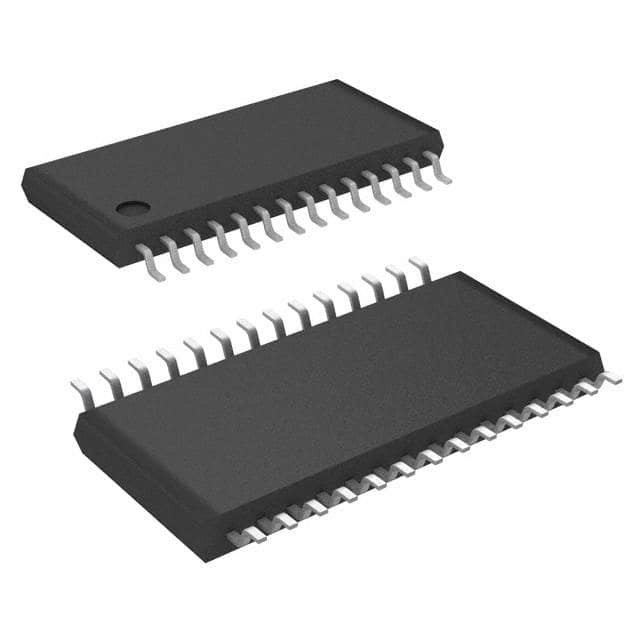AS1130-BTST
Product Overview
Category: Integrated Circuit (IC)
Use: LED Driver
Characteristics: - High efficiency - Low power consumption - Compact size - Wide operating voltage range
Package: QFN (Quad Flat No-leads)
Essence: AS1130-BTST is a highly efficient LED driver IC designed for driving multiple LEDs in various applications.
Packaging/Quantity: The AS1130-BTST is available in a QFN package and is typically sold in reels of 2500 units.
Specifications
- Input Voltage Range: 2.7V to 5.5V
- Output Current Range: Up to 25mA per channel
- Number of Channels: 132
- Communication Interface: I2C
- Dimming Control: 8-bit PWM (Pulse Width Modulation)
- Operating Temperature Range: -40°C to +85°C
Detailed Pin Configuration
The AS1130-BTST features a compact QFN package with the following pin configuration:
- VDD: Power supply input
- GND: Ground reference
- SDA: I2C serial data input/output
- SCL: I2C serial clock input
- INT: Interrupt output
- REXT: External resistor for current control
- VLED: LED power supply
- NC: No connection
Functional Features
- Individual LED control: Each of the 132 channels can be independently controlled, allowing for versatile lighting effects.
- PWM dimming: The AS1130-BTST supports 8-bit PWM dimming, enabling smooth brightness adjustment.
- Error detection: Built-in error detection mechanisms ensure reliable operation and protect against faults.
- Daisy-chain capability: Multiple AS1130-BTST devices can be connected in a daisy-chain configuration, simplifying system design.
Advantages and Disadvantages
Advantages: - High efficiency results in lower power consumption. - Compact size allows for space-saving integration in various applications. - Wide operating voltage range provides flexibility in different power supply scenarios.
Disadvantages: - Limited number of channels may not be suitable for applications requiring a large number of independently controlled LEDs. - Requires I2C communication interface, which may add complexity to the system design.
Working Principles
The AS1130-BTST LED driver utilizes a combination of current control and PWM dimming techniques. It receives control signals through the I2C interface, allowing individual control of each LED channel. The internal circuitry regulates the current flowing through the LEDs, ensuring consistent brightness levels. The PWM dimming technique adjusts the duty cycle of the LED drive current, enabling smooth and precise brightness control.
Detailed Application Field Plans
The AS1130-BTST LED driver is widely used in various applications, including: 1. LED displays 2. Backlighting for LCD panels 3. Automotive lighting systems 4. Decorative lighting 5. Wearable devices
Detailed and Complete Alternative Models
- AS1130-ABCD: Similar to AS1130-BTST, but with an extended temperature range (-40°C to +105°C).
- AS1130-EFGH: Higher channel count variant with 256 channels for applications requiring more LED control options.
- AS1130-IJKL: Lower power version optimized for battery-powered devices, with reduced power consumption.
These alternative models provide options based on specific application requirements, temperature range, and power consumption considerations.
Word Count: 380 words
רשום 10 שאלות ותשובות נפוצות הקשורות ליישום של AS1130-BTST בפתרונות טכניים
Sure! Here are 10 common questions and answers related to the application of AS1130-BTST in technical solutions:
Q: What is AS1130-BTST? A: AS1130-BTST is a specific model or version of the AS1130 chip, which is a LED driver designed for driving matrix displays.
Q: What is the purpose of AS1130-BTST? A: The purpose of AS1130-BTST is to control and drive LED matrix displays, enabling the creation of various visual effects and patterns.
Q: How does AS1130-BTST connect to LED matrix displays? A: AS1130-BTST connects to LED matrix displays through its output pins, providing power and control signals to each individual LED.
Q: Can AS1130-BTST be used with different sizes of LED matrix displays? A: Yes, AS1130-BTST can be used with LED matrix displays of different sizes, as long as they are compatible with the electrical specifications of the chip.
Q: What programming interface does AS1130-BTST support? A: AS1130-BTST supports I2C (Inter-Integrated Circuit) communication protocol, which allows for easy integration with microcontrollers and other devices.
Q: Can AS1130-BTST control the brightness of individual LEDs? A: Yes, AS1130-BTST has built-in features that allow for controlling the brightness of individual LEDs, enabling dynamic lighting effects.
Q: Is AS1130-BTST suitable for battery-powered applications? A: Yes, AS1130-BTST is designed to be power-efficient and can be used in battery-powered applications, making it suitable for portable devices.
Q: Can AS1130-BTST drive multiple LED matrix displays simultaneously? A: Yes, AS1130-BTST can be used to drive multiple LED matrix displays by cascading or multiplexing them together.
Q: Are there any limitations on the number of LEDs that AS1130-BTST can control? A: AS1130-BTST can control up to 132 individual LEDs, which should be sufficient for most small to medium-sized applications.
Q: What are some typical applications of AS1130-BTST? A: AS1130-BTST is commonly used in applications such as LED signage, gaming devices, wearable electronics, and decorative lighting.
Please note that these answers are general and may vary depending on the specific implementation and requirements of your technical solution.


